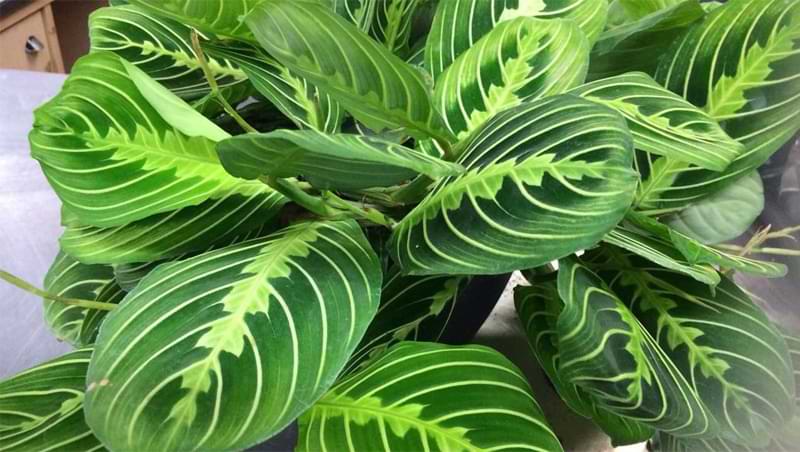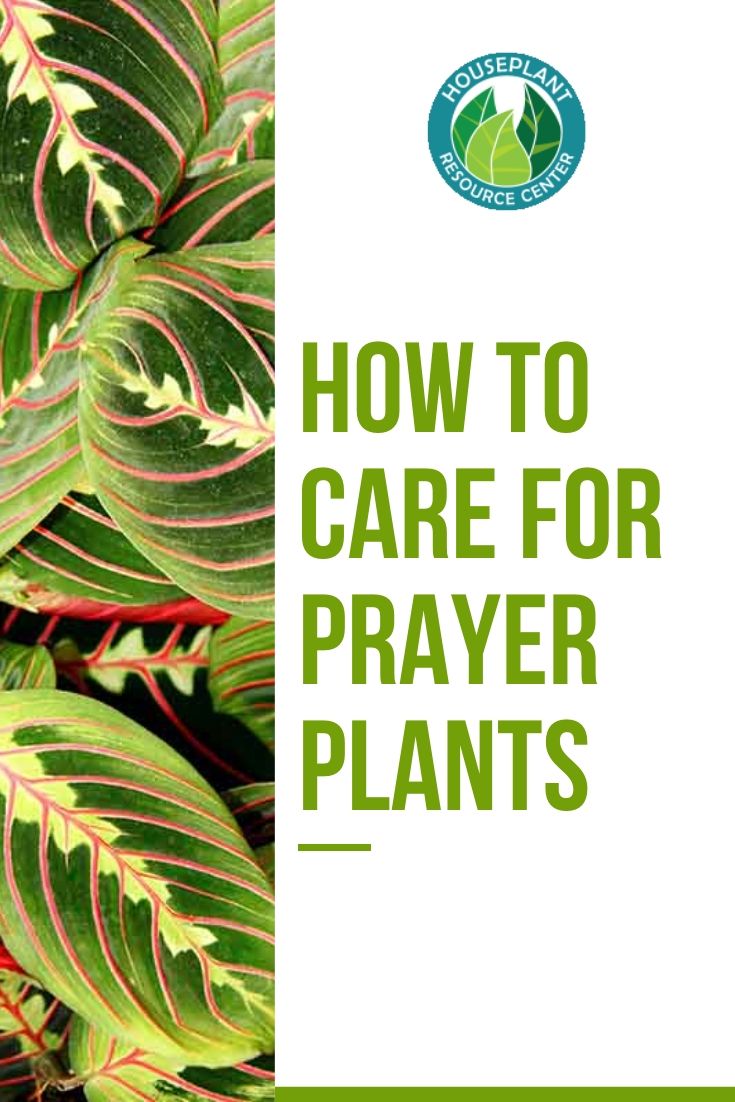Prayer plants are fairly easy to care for, and they’re gorgeous! They’ve been around for a while, but I’ve noticed them a lot lately at my local nursery.
Prayer plants (maranta) are fascinating because they actually fold up at night like hands in prayer. Neat, right?
Prayer plants are actually very colorful, with oblong multi-shade green leaves with bright pink, red, white, or purple veins. These plants come in a few different varieties, such as the red prayer plant, the fishbone/tricolor prayer plant, green prayer plant, pinstripe, etc.

They’re also an excellent houseplant if you don’t have a lot of space because they only reach about a foot tall inside. They’re also quite forgiving about their light conditions, which is good news if your home isn’t especially bright.
Native to Brazil, these plants enjoy conditions similar to what you’d find in a tropical rain forest. Here’s how to care for prayer plants indoors.
How to Care for Prayer Plants:
Potting and Soil
Prayer plants prefer rich, peaty soil and lots of drainage. Choose a nice, loamy potting mix or create your own mix with 50% peat moss, 25% sand, and 25% loam.
Make sure your pot has good drainage so the prayer plant is never sitting in standing water, as this can lead to root rot and other problems.
This plant tends to spread. If it gets too big for its pot, simply repot it and/or divide into smaller plants in their own pots. Simple!
Water
These plants like fairly moist soil, but they don’t like to be soggy.
Water when the top inch of soil feels dry, and when the soil beneath that feels just a little damp. Use lukewarm, distilled water or set tap water out overnight so chlorine and any other chemicals can evaporate (prayer plants are sensitive to these).
They’ll usually require less water in the winter, but never let the soil dry out completely. (Using a moisture meter like this one helps to know just how thirsty your plant is.)
Light
As rain forest plants, these plants do pretty well in low light conditions, but they prefer bright, indirect sunlight. Never put your prayer plant directly in the sun’s rays, because this can scorch the leaves and even cause them to lose their distinct coloring!
Temperature and Humidity
Think rain forest conditions here. Prayer plants like a fairly warm, humid environment, so put it in a spot that stays between 65 and 80 degrees Fahrenheit and is not exposed to drafts or vents, because these will dry your plant right out.
If you live in a dry climate, you may want to supplement with a humidifier, pebble tray, nearby bowls of water, or lots of other plant buddies to raise the relative humidity. This is also a great plant to keep in a bathroom!
If you do not supply enough humidity, get ready for shriveled, crispy leaves in no time.
Fertilizer
Fertilize lightly during the spring and summer with Indoor Plant Food. (And you can fertilize almost all your houseplants with this!) I just add a little to my watering can each week when I water all my plants, and they love it. And I love that I don’t have to remember a fertilizing schedule!
Propagation
Propagate by separating or taking a cutting just below a node. Dip the stem in rooting hormone and place in water or a mix of perlite and peat moss to retain moisture. When roots appear, plant in a pot with prayer plant-friendly potting mix!
About our new Houseplant Propagation Promoter
The exclusive formula of Houseplant Propagation Promoter helps support strong growth and photosynthesis, and it protects new cuttings against bacteria and toxins that can cause new cuttings to fail. With this easy-to-use product, you will be able to clone your best plants more quickly, even tough-to-propagate species like fiddle leaf figs. It also comes with a free Complete Propagation Guide, which includes photos and step-by-step instructions. Click here to buy now.
Good news! Prayer plants are non-toxic for pets and humans.
Troubleshooting:
Here are some potential problems you might run into with your prayer plant AND what to do about them:
- Faded, “bleached”-looking leaves: too much sunlight
- Dark brown spots on the leaves: too much water
- Yellowing on the edges: chemicals in tap water (Switch to distilled or allow chemicals to evaporate.)
- Prayer plants are susceptible to pests like mealybugs and aphids. You can remove insects by picking them off or squirting them off with a kitchen syringe. You can also use a cotton swab dipped in alcohol to kill them and make them easier to remove. Consider using Houseplant Leaf Armor to protect from insects as well as fungus and bacteria.
- Curling, rolled-up leaves: lack of water (leaves may also brown and dry out), chemicals in tap water, cold temperatures, or lack of humidity
Prayer plants are absolutely beautiful and a great statement-making plant for small spaces! It’s a wonderful plant to add to your collection, and pretty low-maintenance once you get the hang of it!
Essentials:
- Make sure you’re giving your plants the right nutrients! Our Indoor Plant Food works perfectly for almost all indoor plants, and it’s easy to use. Grab it here!
- Use our premium well-draining potting soil for your houseplant.
- Protect your houseplant from insects, bacteria, and fungus with our Houseplant Leaf Armor. (As an added bonus, the Leaf Armor also cleans and adds shine to your houseplant’s leaves!)
- Use a moisture meter like this one to always know how thirsty your plant is.
To learn more:
- Join us for our free Top Secrets From Fiddle Leaf Fig Growers Webinar or enroll in our free Advanced Fiddle Leaf Fig Care Course.
- Read The Fiddle Leaf Fig Expert, your complete guide to growing healthy fiddle leaf fig plants. The book is available in full-color paperback or Kindle edition on Amazon now!
- Click to join our community on Facebook: Fiddle Leaf Fig Plant Resource Group.




